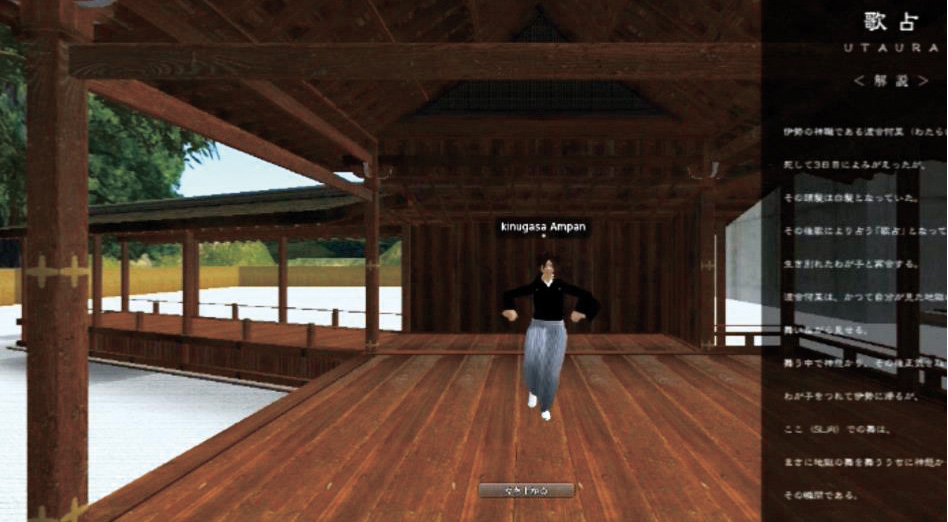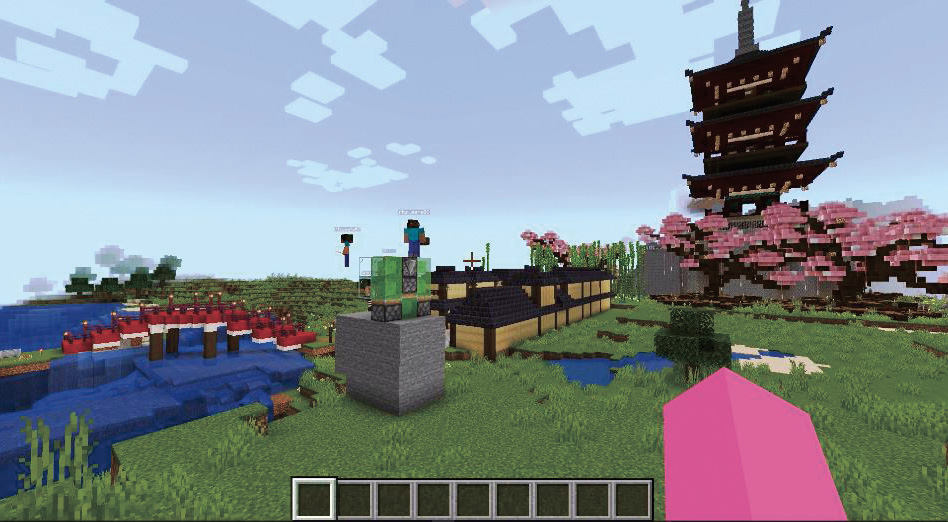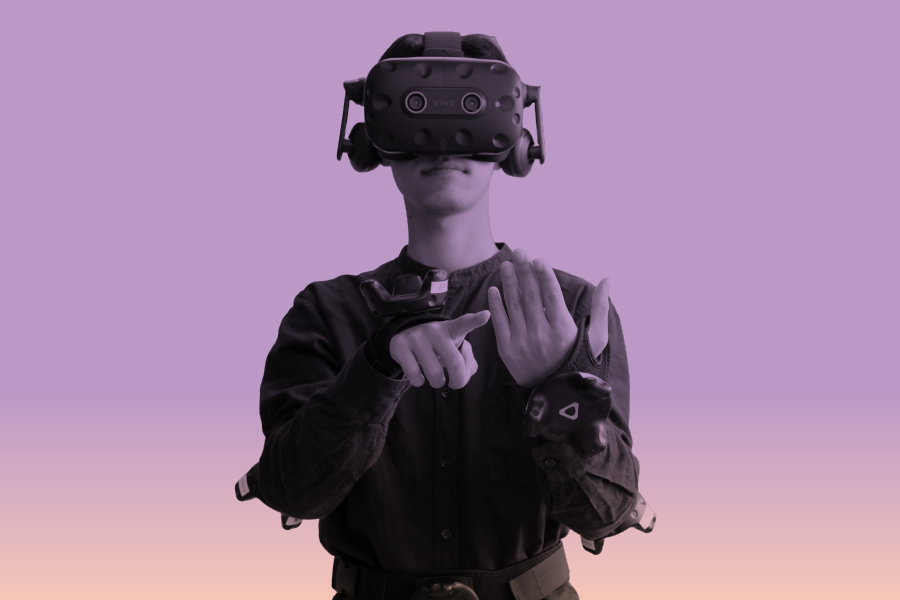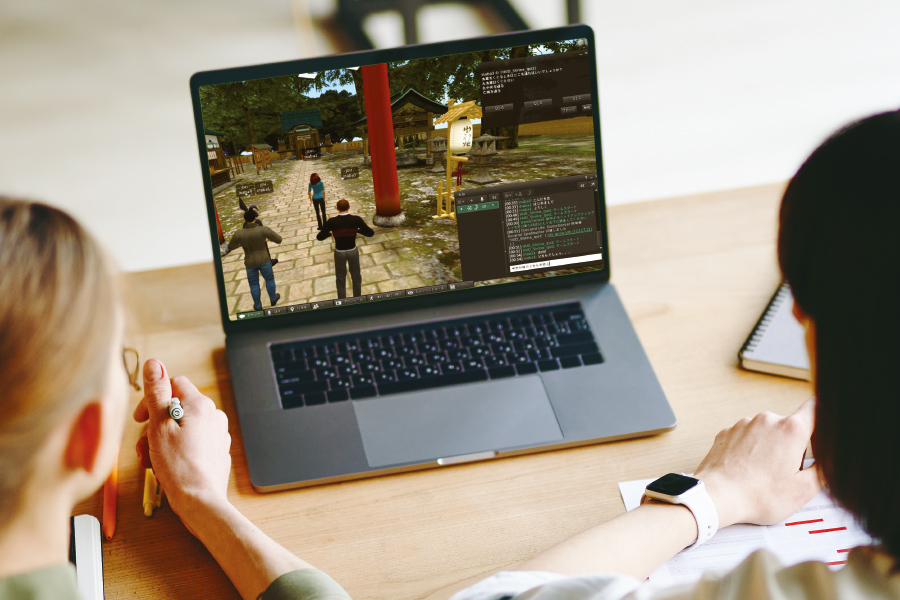STORY #4
Educational Effects of
Collaborative Serious Games
Enjoyed in the Metaverse
Mitsuyuki Inaba
Professor, College of Policy Science
Experiencing the Game
Together Induces
Unexpected Learning
A virtual shrine has been built in the metaverse, a three-dimensional virtual space. A question will be posed when the player’s avatar approaches the front of the torii gate. The question will be, “When you go through the torii gate, where do you pass? Through the middle or close to the posts?” Upon answering the question, the correct answer and explanation will be displayed.
This game, called the “Shrine Worship Game,” allows players to learn about Japanese culture by answering questions as they simulate visiting a shrine in a virtual space. The creator of the game, Mitsuyuki Inaba, has been working on a project to create an environment in the metaverse where people can learn about traditional Japanese culture and lifestyle.
“Before launching the project, my team surveyed foreign researchers and international students already living in Japan to determine what information they lacked relating to living in Japan. We discovered a strong desire to learn about traditional Japanese culture, including the manners of visiting shrines and temples and tea ceremony and flower arrangement etiquette, in addition to general lifestyle and customs. As a result, I thought of creating a system that would allow people to experience and learn about the tangible and intangible aspects of traditional culture through avatars in a virtual space.” Inaba particularly focused on the benefits of using “games” that allow for learning through play.
In a previous project, Second Life (SL)—a globally popular metaverse that enables immersive learning through the use of avatars and which can be accessed from anywhere in the world—was used to create a Virtual Shrine where people could worship virtually and a Virtual Noh Theater where people could experience Noh plays. Mitsuyuki Inaba, the project’s creator, used these virtual spaces as a learning platform and developed a learning model that allowed foreign nationals to learn about traditional Japanese culture using the format of a game. “What’s unique about the model that we implemented in this study is that it uses collaborative serious games, in which learners learn and work together as they engage in the game. For example, in the abovementioned Shrine Worship Game, players with more knowledge about Japanese culture and those with almost no knowledge collaborate on quizzes, creating lively dialogue and facilitating collaborative learning,” Inaba says.
To test the effectiveness of this learning model, Inaba experimented with learning about the Japanese culture with more than 20 pairs of foreign researchers, international students (those who are new to Japanese culture: “newcomers,” hereinafter), and Japanese students (“old-timers,” hereinafter). “In the experiment, the students as old-timers initially took on the role of teaching the newcomers, but as they worked together on quizzes, through communication, the old-timers and the newcomers became equals and learned from each other. This process was observed in most pairs,” Inaba explains. The analysis of the learning effects after the experiment was concluded suggests that not only the newcomers but also the Japanese students as old-timers were able to deepen their knowledge of Japanese culture.
A cross-cultural exchange experiment conducted in collaboration with the University of Hawaii has also shown similar effects. Graduate students at the University of Hawaii constructed a virtual space on SL to impart traditional Hawaiian culture. High school students from Kyoto visited the space, and the graduate students investigated how the visiting students experienced various aspects of Hawaiian culture through their avatars. Inaba and his collaborators observed how the graduate students from Hawaii and high school students from Kyoto actively interacted and learned about each other’s culture. Finding potential in this approach, Inaba comments, “I felt that sharing games and experiences in a virtual space have the potential to induce unexpected learning and mutual understanding.”

The Virtual Shrine is where visitors can learn about the manners of worship and Japanese culture by answering a series of quizzes.

The Virtual Noh Theater, where your avatar can experience Noh performances using motion-captured data from real-life Noh performers.
In his recent research, he has developed a learning model that incorporates a design-based learning approach, in which learners design their own learning environment. One example of this is a Virtual Multinational Restaurant for learning about East Asian food culture.
A virtual restaurant was created within SL, featuring learning content and quizzes on Japanese, Chinese, and South Korean food cultures and customs. International students participated in the project, designing the learning environment and creating the content. They also served as learners using this learning model. “To create the content, the students had to learn about each other’s food cultures. In other words, the students experienced collaborative learning as designers and users of the learning environment,” Inaba explains.
In addition to his work with SL, Inaba is researching a design experiment learning model using Minecraft. Minecraft—sometimes described as a digital block play—is a digital construction game in which players create buildings and other structures using dice-shaped blocks in a three-dimensional virtual space. Inaba was also involved in a project in which high school students from the Oki Islands in Shimane Prefecture used Minecraft to build a Virtual Oki Island that showcases the appeal of the Oki Islands. Another group of high school students from Yawata City, Kyoto Prefecture, have also used Minecraft to reconstruct Shokado Garden, a historic site in the city, in an effort to revitalize the region. As such, he has witnessed the effectiveness of such collaborative learning through these projects.
Rich interactive learning is realized by games that are enjoyed together in the metaverse. It is hoped that Inaba’s research findings will be applied to diverse educational fields.

One of the towns along the Fifty-Three Stations of the Tokaido, re-created by students from Japan, China, and South Korea using Minecraft while researching and discussing the subject.

- Mitsuyuki Inaba
- Professor, College of Policy Science
- Research Themes: Research on the potential social and educational applications of games; Collaborative learning activities for community creation focused on children; Comprehensive research on support environments for cultural “situational learning;” among others
- Specialties: Cognitive science; Learning science; Educational technology; Computer-Supported Collaborative Learning





























